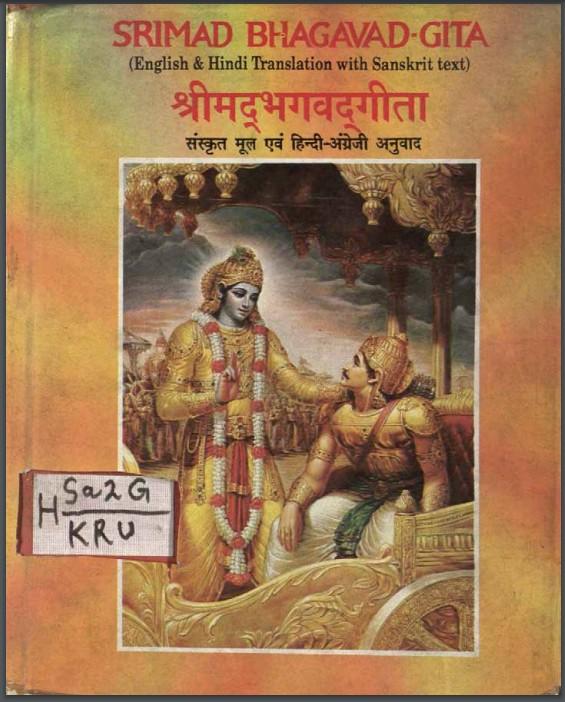
View in Flipbook
Srimad Bhagavad Gita
 English
English
The Bhagavad Gita: A Timeless Spiritual and Philosophical Guide
The Bhagavad Gita, often referred to as the Gita, is a sacred Hindu scripture that has transcended time and geography to become a revered guide for individuals seeking spiritual enlightenment, ethical guidance, and inner peace. Comprising 700 verses, this ancient text is part of the Indian epic Mahabharata and is considered one of the most influential spiritual works ever written. The Gita provides insights into complex topics such as the nature of life, duty (Dharma), righteousness, selfless action, and the ultimate path to liberation (Moksha).
Its teachings are delivered through a dialogue between Lord Krishna, an avatar of the divine, and Prince Arjuna, a warrior conflicted by moral dilemmas on the battlefield of Kurukshetra. The Gita not only addresses the challenges faced by Arjuna but also serves as a metaphor for the struggles and choices that individuals encounter in their own lives. As we explore its profound wisdom, the Bhagavad Gita continues to inspire readers of various cultures, religions, and backgrounds.
The Context and Structure of the Bhagavad Gita
The Bhagavad Gita unfolds on the battlefield of Kurukshetra, where two factions of the Kuru dynasty—the Pandavas and the Kauravas—are preparing for war. As the conflict looms, Arjuna, a skilled archer and one of the Pandava brothers, is overcome by doubt and moral confusion. He faces a dilemma: whether to fulfill his duty as a warrior by fighting or abandon the battlefield to avoid the suffering and death of his loved ones. Arjuna's inner turmoil symbolizes the universal human struggle between duty and moral conflict.
In this moment of crisis, Lord Krishna, serving as Arjuna’s charioteer, imparts timeless wisdom that addresses life’s deepest questions. The dialogue is divided into eighteen chapters, each covering specific themes such as karma (action), dhyana (meditation), bhakti (devotion), and jnana (knowledge). While the Gita is grounded in Hindu philosophy, its teachings are universal and can be applied to daily life, making it a valuable resource for anyone seeking clarity and purpose.
Core Teachings of the Bhagavad Gita
1. Dharma: Understanding One’s Duty
One of the most significant teachings of the Bhagavad Gita is the concept of Dharma, often translated as duty or righteousness. Arjuna’s primary concern in the Gita revolves around his perceived conflict between moral obligations and familial attachments. He hesitates to fight against his relatives and teachers on the opposing side, fearing that it would lead to their destruction and cause his own spiritual downfall.
Krishna explains that one must perform their duty without attachment to the results, emphasizing that Dharma is not about the external outcome but about fulfilling one’s responsibilities with sincerity and integrity. By performing one’s duty with selflessness and dedication, an individual aligns with the natural order of the universe.
This teaching applies not only to warriors like Arjuna but to every individual who faces choices in life. Whether one is a teacher, parent, or professional, acting in accordance with one’s responsibilities without attachment to personal gain or recognition is key to living a righteous life.
“It is better to live your own destiny imperfectly than to live an imitation of somebody else's life with perfection.” — Bhagavad Gita 3.35
2. Karma Yoga: The Path of Selfless Action
Another crucial lesson from the Bhagavad Gita is the principle of Karma Yoga, or the path of selfless action. Krishna teaches that one should act without being driven by the desire for rewards. This does not mean one should be indifferent to the outcome but that the motivation for action should not be rooted in selfish gain.
When individuals perform their duties with detachment, they free themselves from the bondage of karma (the cycle of cause and effect). This idea is beautifully encapsulated in the verse:
“You have the right to perform your prescribed duties, but you are not entitled to the fruits of your actions. Never consider yourself to be the cause of the results of your activities, nor be attached to inaction.” — Bhagavad Gita 2.47
In modern life, this teaching can be a powerful antidote to stress and anxiety, as it encourages individuals to focus on their efforts rather than obsess over outcomes. For example, a student studying for an exam should focus on understanding the material and giving their best effort without being consumed by worries about grades.
3. Jnana Yoga: The Path of Knowledge
The Bhagavad Gita emphasizes the importance of knowledge and wisdom through the path of Jnana Yoga. Krishna explains that ignorance is the root of human suffering, as it blinds individuals to their true nature as eternal souls. The purpose of Jnana Yoga is to cultivate spiritual knowledge and realize the distinction between the physical body, which is temporary, and the soul (Atman), which is eternal.
This realization leads to liberation, as one understands that life’s trials and tribulations are transient and that the soul is beyond the grasp of birth, death, and suffering. Through introspection, meditation, and the study of sacred texts, one can attain self-realization.
In today’s context, Jnana Yoga can inspire individuals to engage in self-reflection and seek knowledge that transcends material pursuits. Understanding the impermanence of life can help individuals prioritize their goals, find peace in adversity, and live with greater purpose.
4. Bhakti Yoga: The Path of Devotion
Perhaps one of the most popular paths in the Bhagavad Gita is Bhakti Yoga, the path of devotion and surrender to the divine. Krishna emphasizes that by surrendering to God with love and devotion, individuals can transcend worldly attachments and attain liberation.
Bhakti Yoga does not require complex rituals or scholarly knowledge. Instead, it involves cultivating a loving relationship with the divine, which can be achieved through prayer, chanting, and selfless service. Krishna reassures Arjuna that devotion to God will protect him and guide him through life’s challenges.
“Whatever you do, whatever you eat, whatever you offer in sacrifice, whatever you give, whatever austerities you perform, do that as an offering to Me.” — Bhagavad Gita 9.27
This teaching highlights the importance of surrender and humility, reminding individuals that life’s challenges can be navigated with faith and trust in a higher power.
Relevance of the Bhagavad Gita Today
The Bhagavad Gita’s teachings are timeless and remain highly relevant in the modern world. As individuals grapple with stress, uncertainty, and moral dilemmas, the Gita offers practical solutions. Its emphasis on self-discipline, mindfulness, and ethical living can help individuals balance material ambitions with spiritual growth.
In the workplace, the concept of Karma Yoga can encourage professionals to focus on effort and teamwork without being driven by competition or personal gain. The idea of Dharma can guide individuals in making ethical decisions, even in challenging circumstances. Moreover, the practice of Bhakti Yoga and mindfulness can provide emotional resilience and inner peace.
Conclusion
The Bhagavad Gita is not merely a religious text; it is a profound spiritual and philosophical guide that addresses universal human concerns. Its wisdom transcends time, culture, and religious boundaries, making it a valuable resource for anyone seeking meaning and purpose in life. Whether one approaches it as a spiritual scripture or a philosophical treatise, the Gita’s teachings on duty, action, devotion, and knowledge can illuminate the path to self-discovery and fulfillment.
By embracing the wisdom of the Bhagavad Gita, individuals can learn to live with integrity, cultivate inner peace, and navigate life’s challenges with grace and wisdom.
You Might Be Interested In
No related eBooks found.

